Every quarterback can improve. Many quarterbacks in college have room to improve considerably. Fighting Irish quarterback Ian Book sent some shock waves throughout the college football world by playing at a high level immediately in his first extended action with Notre Dame. He was quite good, but still has room for improvement, especially after ending the season on a poor note.
Very few quarterbacks, especially those who haven’t played more than one season, have the ability to remain calm in the pocket. Not only to remain calm in the pocket but make good decisions on how to move in the pocket in conjunction with keeping their eyes down field and delivering accurate passes to the right spots. It’s not easy for most quarterbacks.
I would grade Ian Book’s pocket presence as solid to good most of the time. Specifically in the College Football Semifinal against Clemson the Irish offensive line received a lot of criticism although they very quietly held their own, especially in the first half. I wanted to highlight 6 snaps against the Tigers where Book can show pocket awareness improvement in 2019 during his second year of starting.
(Use the time stamps in parentheses for each snap with the video at the bottom of this post)
Snap #1 (12:47)
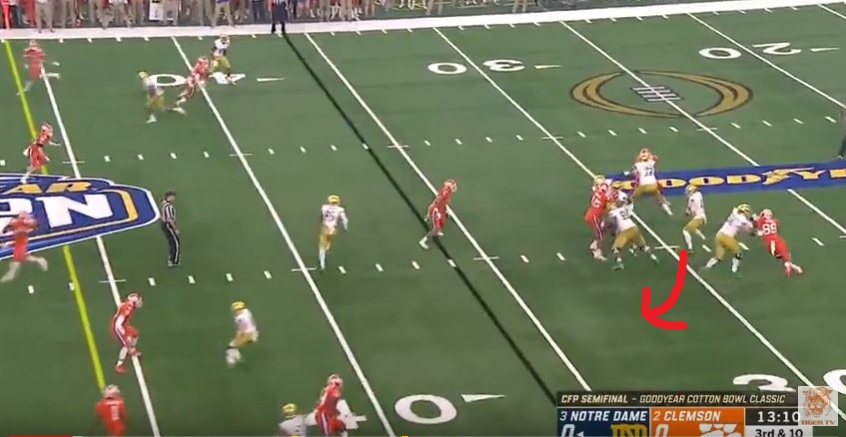
This wasn’t a poor play from Book–it resulted in a key third down drop by Chase Claypool–but it does point out how even when Book made a seemingly correct move it might have left something better on the field.
I noticed Clemson rushed 3 defenders a lot with fake pressure from a 4th defender who often spied Book. The Irish line really didn’t have many problems dealing with this, although the Tigers often drove their ends way outside to force Book to step up and away from perceived pressure (real or not) to his left, right, and back.
That’s exactly what happens on this play for Book. He’s not exactly skittish here, but after 2 seconds he bails out of the pocket and right into the spying defender. He’s able to get a nice touch pass off to the first down marker to Claypool but there wasn’t enough patience to hit Miles Boykin who came free at the top of the screen.
Snap #2 (17:09)
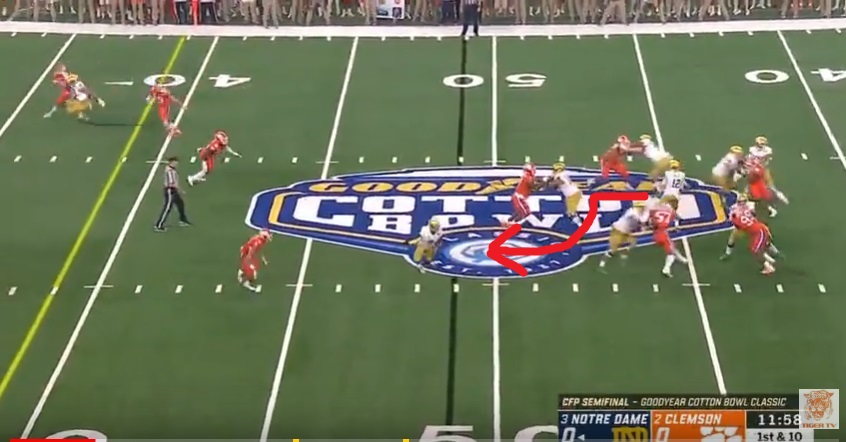
This was a crucial snap early in the game after the Irish had great field position. On first down, Notre Dame runs play-action while Clemson sends a linebacker and 5 total pass rushers. The line picks it up well, pushes the Clemson linemen past Book to form a perfect pocket, and Book smartly takes two hitch-steps and is ready to deliver the ball down field.
But, just as he’s ready to unload Book starts running, crashes into Mustipher’s butt, and gets hit from behind. Lost fumble.
Our friend Jamie Uyeyama covered this snap for Irish Sports Daily back in his “Film Don’t Lie” on January 7th earlier this year. Just as Book steps up in the pocket he had Boykin opening up for a potential touchdown but he never gave that route a chance.
Snap #3 (43:00)
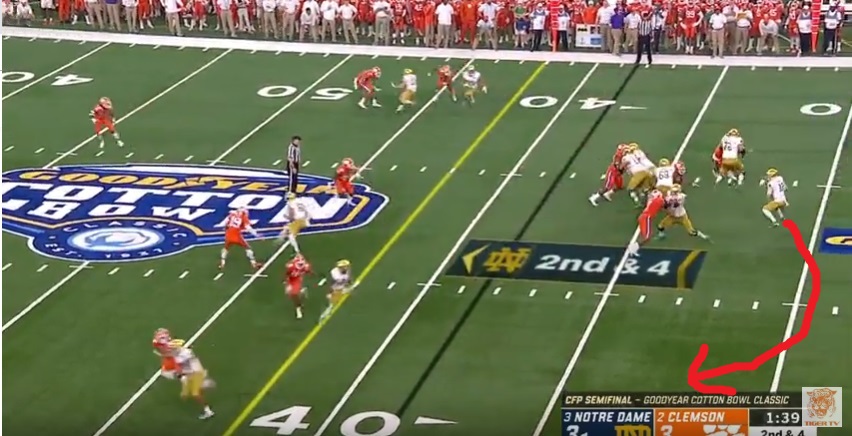
Remember how this game was close for quite a while??
This snaps highlights an area of improvement that could take Book to the next level. Clemson sends 4 rushers against Notre Dame’s 5-man line. The problem is that Albert Huggins beats Irish left guard Aaron Banks with a nice speed move to his right. Book feels that pressure which is good! However, in this freeze-frame he’s already started to turn his shoulders and is about to quickly shuffle to his left.
Now, if he’s going to become an All-American Book could’ve side-stepped and quickly pushed his way up the pocket away from Huggins. Would it be very difficult? Yes, but if he can do that it opens up one of several quick-pass options and a first down throw.
Instead, Book takes off to his left, loops around and is corralled easily for a rush of no gain. These type of runs became increasingly common for Book as the year progressed.
Snap #4 (1:20:38)
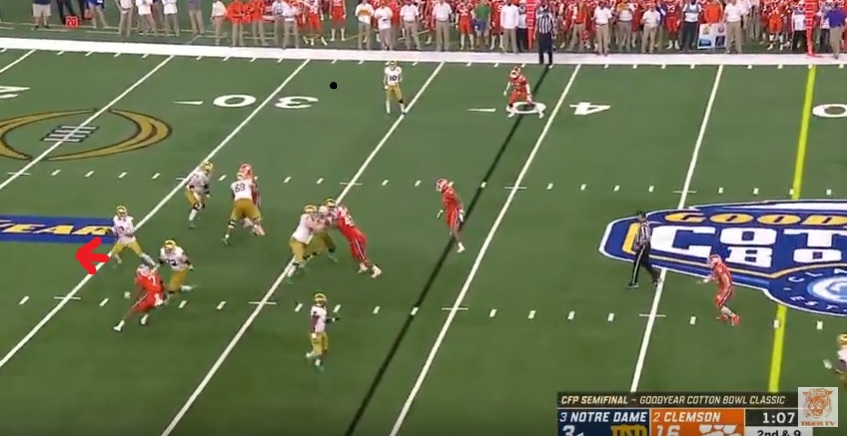
Here’s a passing down late in the first half and Clemson once again only sends 3 rushers with a spy waiting on Book in the middle of the field. The Irish run a play-action, pump fake screen to Finke and Book has plenty of time to re-set in the pocket and scan down field.
For some reason, Book does get skittish at the last second. After nearly 4 seconds of great protection, Book sets his feet seemingly ready to throw then hitch-steps backwards while throwing behind a releasing Tony Jones Jr. out of the backfield.
In a way it didn’t matter, a completed pass to Jones is likely stopped for little or no gain. But it does show that Book could find other options in different areas of the field and he doesn’t have the natural arm strength to complete these passes falling away from the pocket.
Snap #5 (2:01:27)
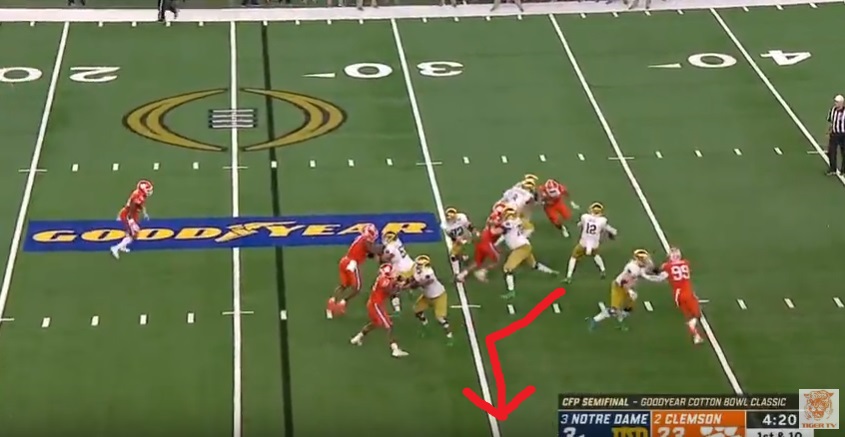
I found a snap later in the 3rd quarter where the protection wasn’t great. Clemson defensive end Austin Bryant stands up and is able to get around tight end Alize Mack after a brief struggle. Jafar Armstrong comes over to offer minimal help but can’t stop the pass rusher.
Now, this isn’t Book’s fault but again in the freeze frame he’s readying to fire the ball down field. Unfortunately, he senses Bryant coming at him from his right and another Clemson interior lineman has crept near his face.
The options for the quarterback here aren’t’ great. Book could’ve thrown to Boykin in single coverage down the left sideline with no safety help–although the corner had good coverage–and Book never looks that way. The two receivers to his right are completely blanketed.
Book does take a 2-step drop and hitches to his right (obviously wanting to throw the ball that way) but does so right into the pass rush. He’s basically trapped and tries to run to his left away from pressure and is dropped for a 2-yard loss. Maybe a pass to Boykin (and turning his head that way) could’ve worked even if it was low percentage. An incompletion is better than a loss of yardage.
Snap #6 (2:25:20)
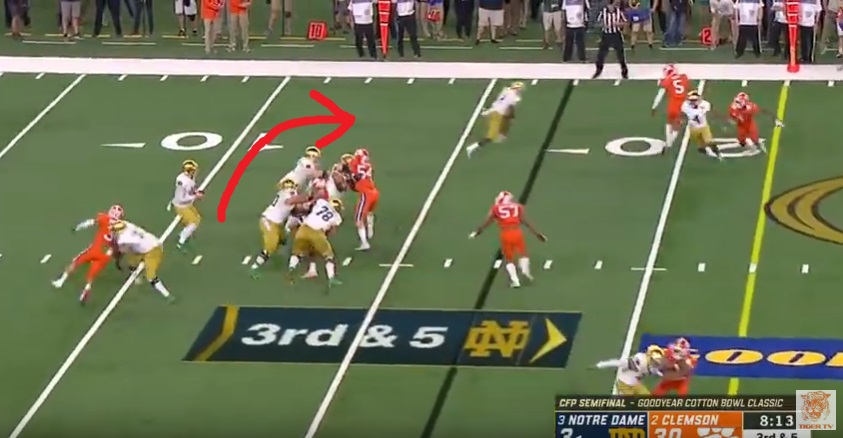
The game is already well out of hand now in the 4th quarter as the Irish face a third and medium inside their own territory. Clemson sends 4 pass rushers then drops an interior lineman back into coverage after a brief attack at Notre Dame’s line. The Irish don’t have a problem with the pass rush as the 5 blocking offensive linemen versus 3 defenders is an easy win as right tackle Robert Hainsey rides freshman 5-star Xavier Thomas a full 9 yards past the line of scrimmage.
Book never gives himself a chance to throw the ball.
If he steps up in the pocket and to his right he’d have all day to throw. Instead, Book barely gives himself time to set his feet on his drop-back and immediately takes off to his left–effectively allowing Thomas a clear lane to chase him and negating Hainsey’s ride block. Worse still, that lineman who dropped back in coverage is able to cut off Book’s race to the first down sticks and prevent a first down.
Recap
The last snap in this post was the only one to go for positive yardage. Out of the 6 snaps featured in total Notre Dame gained 2 yards and lost a fumble.
A lot of focus this off-season will be on Book working on his deep passes. More than arm strength or accuracy I think his ability to improve with pocket presence–especially to buy an extra second for a receiver to come open–will greatly affect his chances at completing passes deep down field.
Maybe more importantly, making smart decisions in the pocket will make Book a better runner–and although it’s not talked about a ton–make up for the fact that he’s listed at 6’0″ and allow him to see better down field. I thought as the season progressed Book became too sloppy and quick-triggered as a runner–meaning he took off too quickly and often into areas of the field where he was angled off by the defense. Even in this game Book ran for 56 yards on 9 carries with sacks removed which is really good. But it was far from enough for an offense that scored only 3 points.
We don’t need to worry too much about Book’s quick-decision making and accuracy when his first option is open. It’s when he’s pressured–or thinks he’s pressured to be more precise–that Book will need to get better finding receivers or running to open space. Kelly has mentioned that Book has improved a lot in this area during the spring and we’ll see if it’s evident some in the Blue-Gold Game.

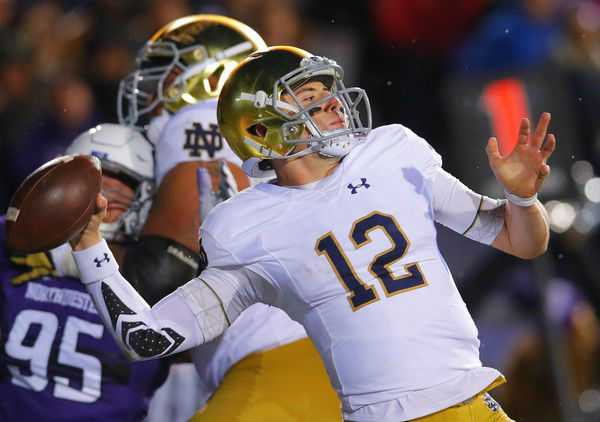

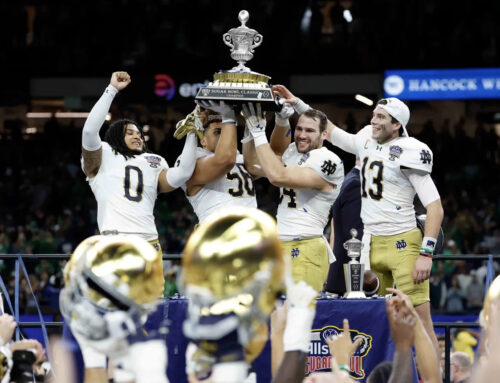
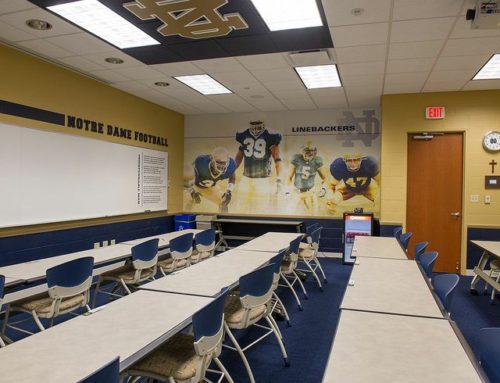
“I thought as the season progressed Book became too sloppy and quick-triggered as a runner–meaning he took off too quickly”
Strong agree. Great job illustrating some of the pocket decisions and areas for improvement. I think the good news is this is hopefully aspects Long can teach and coach up to get some results here and Book hopefully will grow into being the starter.
Really my feeling was dating back to the Pitt game Book showed a lot of inexperience reading defenses and perhaps bailing out too quickly dealing with confusing aspects like d-linemen dropping into coverage. I also felt like he didn’t pass up the middle of the field often either on dropbacks, as if he didn’t trust his eyes to read developing coverages. (Which, to be fair is tough and best to stick with the sure thing).
And for a guy who set school records in completion percentage it feels picky to look for areas of improvement, but it seems like he really does have some room to get better! Hopefully experience will help
He also had a tendency to not step into the pocket to buy time, but rather to try and get to an open side of the field. Almost on a predetermined emergency plan. It was not just an issue in Clemson, but it happened in a lot of the games. A lot of his sacks came from turning right into a defensive end that was blocked well enough to step up, but not around.
Some of it may be height and not being able to see space on the other side. Part of it in that game may have been a belief that the interior of the line would be overwhelmed and there would be more room to the outside.
I imagine it is an inexperience thing. I also think it is a function of the pass routes. We did not run a lot of crossing routes (or at least not complete them) and some of his reads were deliberately kept simple.
Lawrence’s were too, but he has size, arm strength and 5* WRs to win those 1 on 1 battles.
I was amazed by Boykin’s raw numbers at the combine because with those numbers he should have had much better and more consistent separation. Means one of three things. First, he became a workout warrior post season. Second, he took off/didn’t go 100% on too many plays. Third, he is a mediocre route runner. Being where you are expected also makes Book’s job easier.
To your last thought, I read some critiques online (forget where but I want to say it was a PFF-like source) that wasn’t too high on Boykin’s tape for his routes and ability to create separation on a consistent basis at the college level. But the conclusion was that it wasn’t sure how much was on him and/or how much was on the route tree, which they seemed to run down a bit too as rounded and basic in general.
I chalk up most of it to inexperience. I recall how poorly Clausen moved in the pocket for 2007-08 which was hampered by his lack of athleticism. But, he turned away from pressure (so he thought) and into much worse pressure so many times.
As a recruit Boykin ran a sub-4.5 40, so the athleticism he showed at the combine didn’t come out of nowhere. I think he was always a workout warrior and he busted his butt on every play. As to your third possibility, that “mediocre route runner” got behind Clemson’s defense at least three times (one is noted in the first play E highlights) and probably a couple more. I would submit a fourth unconsidered possibility: He did get separation fairly routinely, but Book either didn’t see him (as above) or didn’t pull the trigger quickly enough so the defense had a chance to close (as in another instance against Clemson, or the deep touchdown to Young against Northwestern that could’ve been much easier).
I think Book got skittish in the pocket because of inexperience, plain and simple. It’s a lot harder to trust that the guys are gonna keep you clean when you don’t *know* yet that they’re going to keep you clean. Remember the first time you took a car out on the interstate? You’re so on edge about remembering to signal, checking your mirrors, coming up to speed, etc. that the very existence of the other cars on the road can make you panic. Flash forward to the present, and so much of driving has become second nature that you cut in smoothly while chowing down on your Big Mac and observing the lady three cars up and to the left doing her makeup. I think Book just needs to get comfortable; maybe he can’t get over that hump, but from what we’ve seen of him so far I like his chances.
I also think Book had a tendency to not throw deeper routes and may not have taken advantage of the separation, or the arm strength wasn’t there and the DB had time to catch up.
I doubt he was getting separation routinely. Simply because he was the #1 receiver, an inexperienced QB would always look there first, and if he wasn’t, Rees, Long and Kelly would have reminded him to look for Boykin.
Book did have the tendency to not throw on timing, which is rookie mistake. I think it is also a fear of turnovers. At some point, you need to risk an INT for a good pass.
In a very short time (less than 8 games) Book went from a “game manager” type to being “the Man” in this offense. Did anyone think he he do what he did last season, before game 5, when he was inserted ? I think he needs to grow in trusting himself and his abilities as well as those of his receivers. That’s only natural.
It sounds like all the receivers are making strides this spring and Book too. Maybe the ball will be thrown a split second earlier and Book will show more trust in himself and those receivers. That could mean more 50/50, or better, throws, which could mean lots more offense and a few more turnovers. I will be very surprised if we don’t see an improved version of Ian Book this coming season.
Besides the spy, what other game planning did Clemson do?
A few classic Venables moves, IMO:
1 His linemen were able to control the Irish running game.
2 Too many passing downs for Notre Dame and Clemson was able to cover the short-to-medium passing game really well.
3 Venables uses a lot of zone and man coverage mixed up on a single snap. I think that confused Book a lot and made him really hesitant at times.
Also, Clemson has really good athletes. I was impressed with how well they covered the ND receivers.